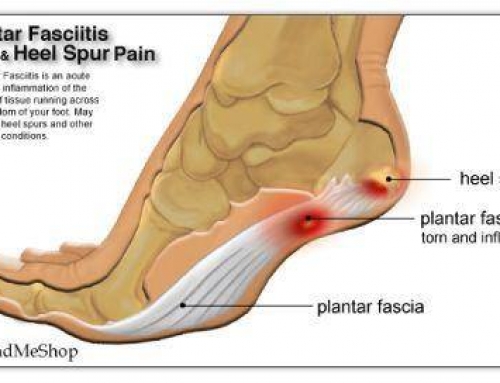The foot and ankle contain dozens of bones and joints—all of which bear the brunt of pressure when you’re running. In fact, when you run, your feet strike the ground with 2 to 3 times the force of your body weight.
It’s no wonder then that several potential foot and ankle injuries can occur as a result of running.
Here is a breakdown of the most common injuries:
Plantar fasciitis
Plantar Fasciitis is a very common problem for runners. It’s caused by an inflamed or damaged plantar fascia (which runs along the bottom of the foot), and it triggers sharp heel pain. This pain may get progressively worse while running, or it may hurt most first thing in the morning when you get out of bed.
Heel pain can also be caused by inflammation of the tendon that connects your calf muscles to your heel (Achilles tendonitis) or by irritation of the bursa sac that sits between the heel bone and Achilles tendon (heel bursitis). These two problems are often confused for each other and can sometimes exist together.
Although the causes of heel pain can be difficult to distinguish, the treatments for these conditions are similar:rest, ice, compression, elevation and stretching.
Stress fracture
The metatarsal bones are the long bones that connect each toe to the midsection of the foot. Through the repetitive stress of running, they are vulnerable to develop small hairline fractures know as stress fractures. Stress fractures may cause little or no pain, or they can cause dull, aching pain that gets worse while running and gets better with rest.
Metatarsalgia and Morton’s neuroma
Stress fractures aren’t the only running injuries that can affect the metatarsal bones. If the heads of the metatarsal bones are irritated or subject to pressure, this can cause pain and irritation in the ball of the foot. The symptoms of metatarsalgia have been described as the feeling of a pebble in your shoe. Morton’s neuroma is similar, but also causes sensations of tingling or shooting pain.
These conditions can improve with rest or a switch to better fitting shoes, but Morton’s neuroma may warrant a trip to the doctor if the pain continues.
Ankle sprain
All of the previous injuries listed are overuse injuries, meaning that they occur not from one traumatic event, but from repetitive forces caused by overtraining or poor biomechanics, which triggers injury.
However ankle Sprains are acute injuries caused by falling or rolling an ankle. Symptoms include immediate ankle pain and weakness, and swelling usually follows shortly after.
As with the other injuries in this post, treatment for a sprained ankle requires rest, ice, compression, and elevation (RICE). It may also be helpful to keep weight off a badly sprained ankle until it is healed enough to better support your weight.
Ankle Sprain and Strain Signs and Symptoms
The symptoms of ankle sprains and strains can be quite similar, but there are some important distinctions. Both involve localized pain, ankle swelling, and instability, but the location and side effects of that pain and instability can differ depending on whether a muscle or ligament is involved.
Symptoms of an ankle sprain
In an ankle sprain, the following signs and symptoms may occur:
Localized pain at the site of the sprain. For example, if the deltoid ligament has been sprained, pain would be localized to the inside of the ankle. Pain is often described as sudden and sharp, and worsens with movement or placing weight on the ankle. Pain may be relieved somewhat by rest and elevation of the ankle.
Swelling at the site of the sprain. In the case of a deltoid ligament sprain, the inside of the ankle may be noticeably swollen. Or swelling may occur on the outside of the ankle if one or more ligaments in the lateral ligament complex are sprained.
Bruising over the site of the sprain. In addition to swelling, patients may notice bluish, reddish, or purplish skin discolorations over the sprain site as an indication that ligaments have torn and blood is rushing to the area.
Limited ability to move the ankle. In more severe sprains, patients may not be able to turn, bend, or flex the foot. Weight-bearing activities such as walking may become difficult or impossible.
Popping sound or sensation. When the injury occurs, patients may hear or feel a “pop” as the ligament is stretched or torn.
Intense pain at the time of the trauma. In cases of severe sprains when the ligament(s) is partially or completely torn, the pain is sudden and severe enough to make patients stop whatever they are doing and become immobile.
Symptoms of an ankle strain
While most ankle sprains are acute injuries that occur following a single trauma, ankle strains can be either acute or chronic. Acute strains can occur following a single trauma, such as slipping and falling on a patch of ice or running and jumping during sports. Chronic strains usually occur due to longer-term overuse of the ankle muscles, and frequently occur in long-distance runners, soccer and American football players, gymnasts, and dancers.
If you are experiencing foot or ankle pain and self-care steps such as rest, ice, or stretching have not improved your symptoms after a few weeks, make an appointment with your doctor so you can get an accurate diagnosis and treatment.


